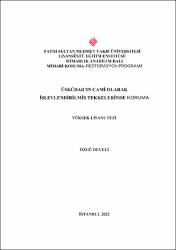| dc.contributor.advisor | Numan, İbrahim | |
| dc.contributor.author | Develi, Özgü | |
| dc.date.accessioned | 2024-03-15T13:41:10Z | |
| dc.date.available | 2024-03-15T13:41:10Z | |
| dc.date.issued | 2022 | en_US |
| dc.identifier.citation | DEVELİ, Özgü, Üsküdar’ın Cami Olarak İşlevlendirilmiş Tekkelerinde Koruma, Fatih Sultan Mehmet Vakıf Üniversitesi Lisansüstü Eğitim Enstitüsü Mimarlık Anabilim Dalı Mimari Koruma-Restorasyon Programı, Yayımlanmamış Yüksek Lisans Tezi, İstanbul 2022. | en_US |
| dc.identifier.uri | https://hdl.handle.net/11352/4822 | |
| dc.description.abstract | İslâm’ın doğuşunu takip eden 2. ve 3. yüzyıllardan itibaren Hz. Peygamber yaşantısını kendine örnek alan, İslâm’ın emir ve yasaklarına uymakta titiz davranan, yayılmacı anlayışı (fütüvvet) benimsemiş insanların, zaman içerisinde artıp kurumsallaşmasıyla tekkeler oluşmuştur. Türk ve İslâm aleminde bir kolonizasyon yayılma, yerleşme, İslâmlaştırma aracı olarak kullanılmışlardır. İlk zamanlar farklı ihtiyaçlar sebebiyle farklı şekil ve isimlerde karşımıza çıkan tekkeler, Osmanlıdan günümüze zikir ve ibâdet yerleri, bulundukları toplumun okul ve sosyal yardım yerleri, misâfirhâne, şifâhâne, edebiyat, felsefe, müzik, spor, meslek eğitiminin verildiği merkezler olarak bilinmektedir.
Üsküdar’ın, İstanbul’un fethinde maddi ve manevi kapı niteliğinde olduğu muhakkaktır. Ancak bu sosyal dokuyu yoğurmuş, şimdilerde yok olan ve yok olmaya yüz tutmuş onlarca tekkeden yeteri kadar bahsedilmemektedir.
18. yüzyıl sonlarından 1925 yılına kadar tekkelere ait listelerin verildiği kaynaklara göre bugünkü ilçe sınırları dikkate alındığında Üsküdar’da 76 ayrı tekke bulunmaktaydı ve bu sayı tek başına Üsküdar’daki mânevî yaşantının zenginliğini göstermektedir (Köseoğlu, 2015).
Çalışmada konunun sınırlandırılması açısından 1925 sonrası kapatılıp bir kısmının yok olduğu, bir kısmının ihyâ edilip farklı sosyal fonksiyonlarla kullanıldığı Üsküdar tekkelerinden, câmi olarak işlevlendirilip günümüze ulaşabilmiş olan dokuz tekke ele alınmıştır. Bu tekkeler günümüzde câmi olarak bilinmektedir ancak tekke olarak kurulmuş veya bir dönem tekke olarak kullanılmıştır.
Çalışmada Üsküdar tekkeleri için genel bir tipoloji çıkartılıp, mekânsal ilişkileri tartışılmıştır. Mevcut ve yerinde olmayan olarak tablolar yapılmış; çeşitli kaynaklarda isimleri geçen Üsküdar tekkelerinin isimleri, konumları, mevcutta bulunma, kullanım durumları ve bağlı bulundukları tarîkatlar yazılmıştır.
İşlev değişikliği konusuna koruma bağlamında değinilmiş, tekkelerin kapatılması kanunu ile SOKÜM’ ün öneminden bahsedilmiş, Kültür Bakanlığı’nın “Meydan
Meşkleri” korosunun konumuz kapsamında yeri anlatılmıştır. Üsküdar tekkelerinin tarihleri, konumları, mîmârî özellikleri, geçirdiği değişim ve onarımlar, işlevlendirme ve yapısal korunma önerileri ele alınmıştır. | en_US |
| dc.description.abstract | From the 2nd and 3rd centuries following the birth of Islam, Dervish lodges were formed by the people who follow the Prophet Muhammad’s footsteps as an example, who were attentive to obeying the principles and prohibitions of Islam, and who adopted the expansionist understanding (fütüvvet). They were used as a means of colonization, expansion, settlement and Islamization in the Turkish and Islamic worlds. Dervish lodges, which appeared in different shapes and names due to different needs in the early times, are known as places of dhikr and worship, school and social aid places of the society they are in, guesthouse, healing and training centers that include literature, philosophy, music, sports, and some professional fields. It is certain that Üsküdar was a material and spiritual gate in the conquest of Istanbul. However, these tens of lodges, which have repaired the social fabric and are on the verge of extinction, are not mentioned enough. According to the given sources in the lists of lodges from the late 18th century to 1925, there were 76 different lodges in Üsküdar by considering today's district borders, and this number alone shows the richness of the spiritual life in Üsküdar (Köseoğlu, 2015). In terms of limitation of the subject in the study, Üsküdar lodges, which were closed after 1925 and some of them were destroyed, some of them were revived and used for different social functions, nine dervish lodges which were used as mosques and survived to the present day, were discussed. These lodges are known as mosques today, but they were established as lodges or used as lodges for a while. In the study, a general typology for Üsküdar lodges was drawn and their spatial relations were discussed. Tables were made as existing and unavailable lodges. The names of the Üsküdar dervish lodges, whose names are mentioned in various sources, their locations, existence, usage situations and the sects that they are registered, are written. The issue of functional change was touched on the context of protection, the law of closure of lodges and the importance of SOKÜM were mentioned, The "Meydan Meşkler" choir of the Ministry of Culture is explained within the scope of our subject. The years, locations, architectural features, changes and repairs, functionalization and structural protection suggestions of Üsküdar lodges are discussed. | en_US |
| dc.language.iso | tur | en_US |
| dc.publisher | Fatih Sultan Mehmet Vakıf Üniversitesi | en_US |
| dc.rights | info:eu-repo/semantics/openAccess | en_US |
| dc.subject | Üsküdar | en_US |
| dc.subject | Tekke | en_US |
| dc.subject | Koruma | en_US |
| dc.subject | Yeniden İşlevlendirme | en_US |
| dc.subject | Vakıf | en_US |
| dc.subject | Dervish Lodge | en_US |
| dc.subject | Protection | en_US |
| dc.subject | Refunctionalization | en_US |
| dc.subject | Foundation | en_US |
| dc.title | Üsküdar’ın Cami Olarak İşlevlendirilmiş Tekkelerinde Koruma | en_US |
| dc.title.alternative | Üsküdar’s Used as a Mosque Dervish Lodges’ of Functional Change | en_US |
| dc.type | masterThesis | en_US |
| dc.contributor.department | FSM Vakıf Üniversitesi, Lisansüstü Eğitim Enstitüsü, Mimarlık Ana Bilim Dalı Ana Bilim Dalı | en_US |
| dc.relation.publicationcategory | Tez | en_US |
| dc.contributor.institutionauthor | Develi, Özgü | |



















